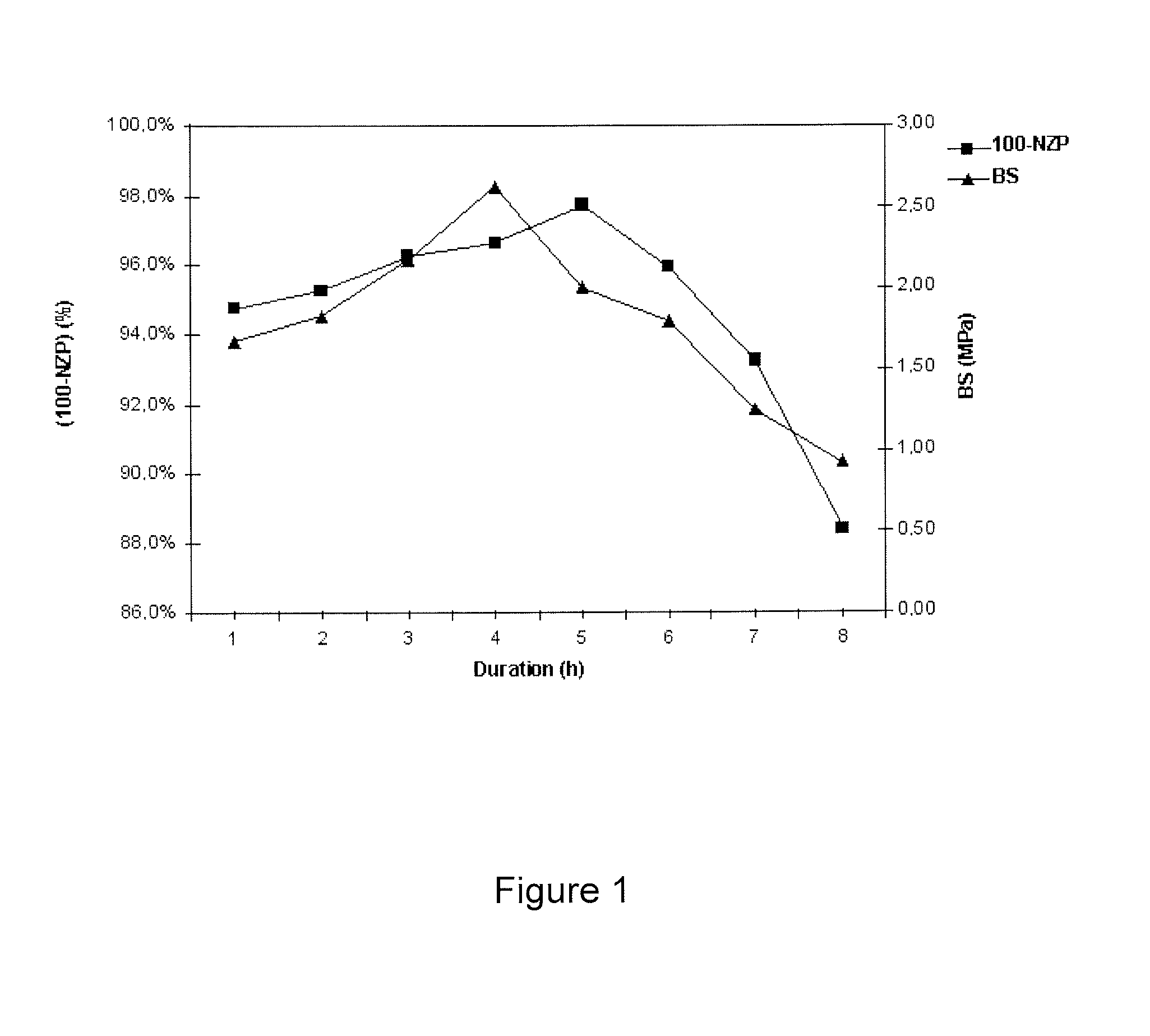Zeolitic adsorbents, their process of preparation and their uses
a technology of adsorbents and zeolitic agglomerates, which is applied in the field of adsorbents, can solve the problems of deterioration in performance, reduced adsorption properties of zeolitic agglomerates in comparison with the powder formed of crystals, and difficult use on the industrial scal
- Summary
- Abstract
- Description
- Claims
- Application Information
AI Technical Summary
Benefits of technology
Problems solved by technology
Method used
Image
Examples
example a
Synthesis of Crystals of Zeolite X, with an Si / Al Atomic Ratio of 1.25, with a Number-Average Diameter of 1.0 μm and with an Na / Al Atomic Ratio of 1
[0113]A gel having the molar composition 3.5 Na2O, 2.8 SiO2, Al2O3 and 130 H2O is prepared by mixing the following reactants: sodium silicate, sodium aluminate and water. The gel is matured at 35° C. for 20 hours and a crystallization is carried out at 100° C. for 4 hours.
[0114]The crystals obtained after filtration and washing are identified by X-ray diffraction (XRD analysis) as being faujasite crystals. The chemical analysis of the solid gives an Si / Al atomic ratio of 1.25. The micropore volume, evaluated from the Dubinin-Raduskevitch equation as described in the technical characterization part and expressed in cm3 per gram of dry adsorbent, is 0.345±0.003 cm3 / g. The size of the zeolite crystals is analysed by scanning electron microscopy and shows that their number-average diameter is 1.0 μm.
example b
Synthesis of Crystals of Zeolite X, Si / Al=1.20, Diameter 0.8 μm
[0115]A gel having the molar composition 4 Na2O, 2.8 SiO2.Al2O3 and 130 H2O is prepared by mixing the reactants: sodium silicate, sodium aluminate and water, using a turbine mixer. The gel is allowed to mature at 35° C. for 20 hours and a crystallization is carried out at 100° C. for 4 hours.
[0116]The crystals obtained after filtration and washing are identified by X-ray diffraction (XRD analysis) as being faujasite crystals. The chemical analysis of the solid gives an Si / Al atomic ratio of 1.20±0.03. The micropore volume, evaluated from the Dubinin-Raduskevitch equation as described above and expressed in cm3 / g of dry adsorbent, is 0.344±0.003 cm3 / g. The size of the zeolite crystals is analysed by scanning electron microscopy: their number-average diameter is 0.8 μm.
Preparation of the Zeolitic Adsorbents
[0117]A homogeneous mixture is prepared and 800 g of crystals of zeolite NaX, prepared according to the procedures des...
example 1
[0118]200 g of agglomerates obtained from the powder synthesized in Example A are placed in a glass reactor provided with a jacket regulated at a temperature of 100° C.±1° C., 1.5 l of a 2.5M aqueous sodium hydroxide solution are then added and the reaction medium is left stirring for a period of time which can vary from 1 hour to 8 hours, as shown in the table below.
[0119]The agglomerates are subsequently washed in 3 successive operations of washing with water, followed by the emptying of the reactor. It is ascertained that the washing is effective by measuring the final pH of the aqueous wash liquors of between 10.0 and 10.5.
[0120]These agglomerates are used in a cationic exchange reaction by action of a 0.5M aqueous barium chloride solution at 95° C. in 4 stages. At each stage, the ratio of volume of solution to weight of solid is 20 ml / g and the exchange is continued for 4 hours on each occasion. Between each exchange, the solid is washed several times, so as to free it from exc...
PUM
| Property | Measurement | Unit |
|---|---|---|
| Temperature | aaaaa | aaaaa |
| Fraction | aaaaa | aaaaa |
| Fraction | aaaaa | aaaaa |
Abstract
Description
Claims
Application Information
 Login to View More
Login to View More - R&D
- Intellectual Property
- Life Sciences
- Materials
- Tech Scout
- Unparalleled Data Quality
- Higher Quality Content
- 60% Fewer Hallucinations
Browse by: Latest US Patents, China's latest patents, Technical Efficacy Thesaurus, Application Domain, Technology Topic, Popular Technical Reports.
© 2025 PatSnap. All rights reserved.Legal|Privacy policy|Modern Slavery Act Transparency Statement|Sitemap|About US| Contact US: help@patsnap.com

